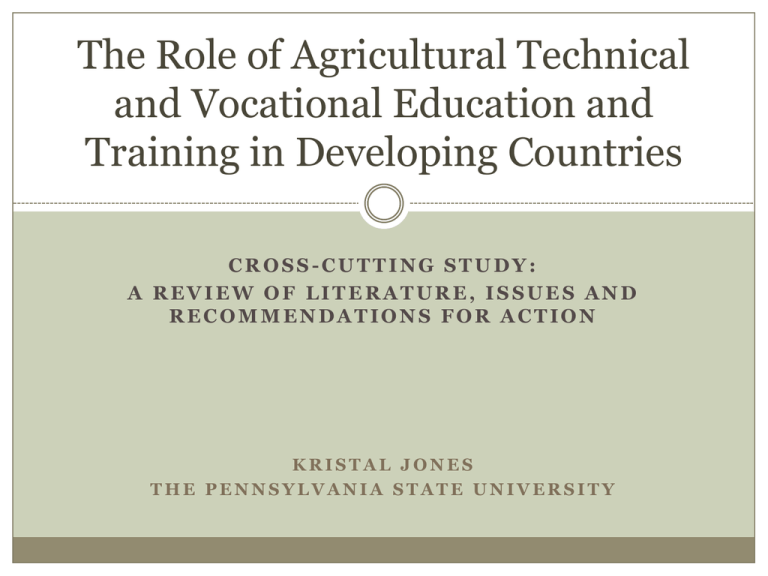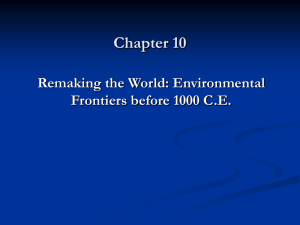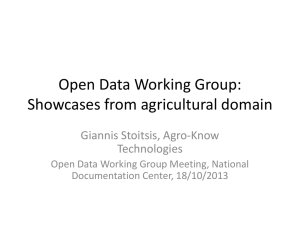The Role of Agricultural Technical and Vocational
advertisement

The Role of Agricultural Technical and Vocational Education and Training in Developing Countries CROSS-CUTTING STUDY: A REVIEW OF LITERATURE, ISSUES AND RECOMMENDATIONS FOR ACTION KRISTAL JONES THE PENNSYLVANIA STATE UNIVERSITY What is ATVET? Credit: CAADP – Ghana Credit: TaiwanICDF – St. Kitts and Nevis Credit: USAID/STAY+ – Afghanistan What is TVET? UNESCO (2004): Technical and vocational education and training is a comprehensive term referring to those aspects of the educational process involving, in addition to general education, the study of technologies and related sciences, and the acquisition of practical skills, attitudes, understanding and knowledge relating to occupations in various sectors of economic and social life What is ATVET? The study of technologies and related sciences, and the acquisition of practical skills, attitudes, understanding and knowledge relating to agricultural occupations What is ATVET? The study of technologies and related sciences, and the acquisition of practical skills, attitudes, understanding and knowledge relating to agricultural occupations What are agricultural occupations, and what kind of skills and education are related to them? Value chains define agricultural occupations Agricultural value chain Graphic: USAID Value chains define agricultural occupations Agricultural value chain Farmers, fishers, herders, foresters Value chains define agricultural occupations Agricultural value chain Farmers, fishers, herders, foresters Agrodealers, seed producers, extension agents Value chains define agricultural occupations Agricultural value chain Food processing and conservation for local markets Farmers, fishers, herders, foresters Agrodealers, seed producers, extension agents Value chains define agricultural occupations Agricultural value chain (Local and regional agribusiness) Food processing and conservation for local markets Farmers, fishers, herders, foresters Agrodealers, seed producers, extension agents Value chains define agricultural occupations Agricultural value chain (Local and regional agribusiness) Food processing and conservation for local markets Farmers, fishers, herders, foresters Agrodealers, seed producers, extension agents Value chains define agricultural occupations Agricultural value chain (Local and regional agribusiness) Farmer unions, producer organizations, mechanics Food processing and conservation for local markets Farmers, fishers, herders, foresters Agrodealers, seed producers, extension agents Value chains define agricultural occupations Agricultural value chain (Local and regional agribusiness) Farmer unions, producer organizations, mechanics Agricultural banks, credit unions, private credit and microfinance Food processing and conservation for local markets Farmers, fishers, herders, foresters Agrodealers, seed producers, extension agents Value chains define agricultural occupations Agricultural value chain Third-party certifiers Farmer unions, producer organizations, mechanics Agricultural banks, credit unions, private credit and microfinance (Local and regional agribusiness) Food processing and conservation for local markets Farmers, fishers, herders, foresters Agrodealers, seed producers, extension agents Occupations define the skills needed Hard skills Production techniques Land, soil, water management Accurate information about inputs Certification compliance and assessment Business planning and management Occupations define the skills needed Hard skills Production techniques Land, soil, water management Accurate information about inputs Certification compliance and assessment Business planning and management Soft skills Leadership Personal financial planning Communication Applications of information technology Skills define the appropriate level of education Historically, post-primary vocational education aimed at “the sons of traditional farmers,” whereas postsecondary education was designed to “lead the sons of the middle class into public employment.” (Johanson and Saint 2007: 13) In the future, “farmers, fishers, foresters and miners will require at least fourteen years of education” in order to run computer-operated machinery and perform technical tasks. (UNESCO, 2006a: 11) ATVET & agricultural workforce development SWOT analysis of the contributions of ATVET to agricultural workforce development Strengths Weaknesses Relative cost Lack of continuity with TVET systems Responsiveness to demand Overly narrow and technical focus Provision of relevant skills Marginalization of diverse groups Accessibility to diverse populations Irrelevant or inaccessible training Experiential learning Incorporation of sustainability Opportunities Threats Value chains create new types of jobs Lack of institutional support Increased integration of educational levels Changing education priorities Emphasis on rural livelihoods Outdated pedagogy Emphasis on agricultural entrepreneurship Out-migration from agriculture Stigma of vocational education ATVET & agricultural workforce development SWOT analysis of the contributions of ATVET to agricultural workforce development Strengths Weaknesses Relative cost Lack of continuity with TVET systems Responsiveness to demand Overly narrow and technical focus Provision of relevant skills Marginalization of diverse groups Accessibility to diverse populations Irrelevant or inaccessible training Experiential learning Incorporation of sustainability Opportunities Threats Value chains create new types of jobs Lack of institutional support Increased integration of educational levels Changing education priorities Emphasis on rural livelihoods Outdated pedagogy Emphasis on agricultural entrepreneurship Out-migration from agriculture Stigma of vocational education ATVET & agricultural workforce development SWOT analysis of the contributions of ATVET to agricultural workforce development Strengths Weaknesses Relative cost Lack of continuity with TVET systems Responsiveness to demand Overly narrow and technical focus Provision of relevant skills Marginalization of diverse groups Accessibility to diverse populations Irrelevant or inaccessible training Experiential learning Incorporation of sustainability Opportunities Threats Value chains create new types of jobs Lack of institutional support Increased integration of educational levels Changing education priorities Emphasis on rural livelihoods Outdated pedagogy Emphasis on agricultural entrepreneurship Out-migration from agriculture Stigma of vocational education ATVET & agricultural workforce development SWOT analysis of the contributions of ATVET to agricultural workforce development Strengths Weaknesses Relative cost Lack of continuity with TVET systems Responsiveness to demand Overly narrow and technical focus Provision of relevant skills Marginalization of diverse groups Accessibility to diverse populations Irrelevant or inaccessible training Experiential learning Incorporation of sustainability Opportunities Threats Value chains create new types of jobs Lack of institutional support Increased integration of educational levels Changing education priorities Emphasis on rural livelihoods Outdated pedagogy Emphasis on agricultural entrepreneurship Out-migration from agriculture Stigma of vocational education ATVET & agricultural workforce development SWOT analysis of the contributions of ATVET to agricultural workforce development Strengths Weaknesses Relative cost Lack of continuity with TVET systems Responsiveness to demand Overly narrow and technical focus Provision of relevant skills Marginalization of diverse groups Accessibility to diverse populations Irrelevant or inaccessible training Experiential learning Incorporation of sustainability Opportunities Threats Value chains create new types of jobs Lack of institutional support Increased integration of educational levels Changing education priorities Emphasis on rural livelihoods Outdated pedagogy Emphasis on agricultural entrepreneurship Out-migration from agriculture Stigma of vocational education Examples of recent ATVET projects Organization USAID Country Mozambique Occupation Production IPA Uganda AfDB World Bank Ethiopia Education USAID Egypt Education IFAD Production Business Land O’Lakes Bangladesh Madagascar Rwanda East Timor IFAD Mongolia Skills Junior Farmer Field Life Schools Educational level Non-formal Cash transfers to youth to pay vocational training fees Extension/Development Agent in: Animal Science Animal Health Agricultural Cooperatives Natural Resources Plant Science Curriculum development that fits within a value chain approach Secondary Secondary Business Management Livestock rearing Fish hatcheries Microenterprise Agribusiness Farm management Transport Machinery Driving Welding Post-secondary Post-secondary ATVET in Kyrgyzstan: An example Agricultural and Rural Vocational Education Project (Helvetas and partners) Source: Helvetas 2011 Annual Report ATVET in Kyrgyzstan: An example Agricultural and Rural Vocational Education Project (Helvetas and partners) Source: Helvetas 2011 Annual Report ATVET in Kyrgyzstan: An example Training and Extension System rural advisory services (GIZ, Osh University, USAID, UNDP) Source: tes-centre.org InnovATE and ATVET Place-based labor market analysis What are agricultural occupations? What skills are necessary for these occupations? What level of education is appropriate for these skills? InnovATE and ATVET Place-based labor market analysis What are agricultural occupations? What skills are necessary for these occupations? What level of education is appropriate for these skills? Capacity building Institutional Pedagogical Creating linkages – extension, universities, private sector Questions? Credit: CAADP – Ghana Credit: TaiwanICDF – St. Kitts and Nevis Credit: USAID/STAY+ – Afghanistan







